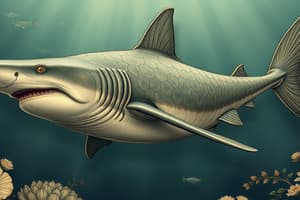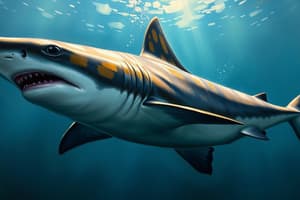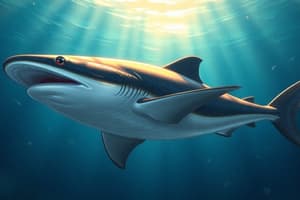Podcast
Questions and Answers
What are the different characteristics of male and female sharks?
What are the different characteristics of male and female sharks?
Females are larger (sexual dimorphism) and have 3x thicker skin. Males have claspers for internal fertilization.
What color can sharks see in dim light?
What color can sharks see in dim light?
Green
What color can sharks see in midday?
What color can sharks see in midday?
Yellow
What are the hard scales of sharks called?
What are the hard scales of sharks called?
Do sharks possess a swim bladder?
Do sharks possess a swim bladder?
What are sharks most sensitive to in the water?
What are sharks most sensitive to in the water?
Which type of shark comes into fresh water and is considered man-eating?
Which type of shark comes into fresh water and is considered man-eating?
Name all the sharks that are considered man-eaters.
Name all the sharks that are considered man-eaters.
Why do sharks possess a spiral-shaped intestine?
Why do sharks possess a spiral-shaped intestine?
What organ is large in the shark's body?
What organ is large in the shark's body?
What was referred to as marine gold and sold in capsules at $1 a pill?
What was referred to as marine gold and sold in capsules at $1 a pill?
Why are sharks disappearing?
Why are sharks disappearing?
What are the Ampullae of Lorenzini?
What are the Ampullae of Lorenzini?
How many species of sharks are there?
How many species of sharks are there?
Do sharks have eyelids?
Do sharks have eyelids?
Do sharks have a subterminal mouth?
Do sharks have a subterminal mouth?
What percent of sharks give live birth and what percent lay egg cases?
What percent of sharks give live birth and what percent lay egg cases?
Do sharks possess an operculum?
Do sharks possess an operculum?
What does elasmobranch mean?
What does elasmobranch mean?
Why must pelagic sharks always swim?
Why must pelagic sharks always swim?
What type of egg do sharks produce?
What type of egg do sharks produce?
Do great white sharks give live birth?
Do great white sharks give live birth?
Do males and females remain separate until mating time?
Do males and females remain separate until mating time?
What is the most common pelagic shark?
What is the most common pelagic shark?
Upper jaw is for _____ and lower jaw is for ____.
Upper jaw is for _____ and lower jaw is for ____.
What color do sharks avoid?
What color do sharks avoid?
What are characteristics of rays?
What are characteristics of rays?
What are characteristics of skates?
What are characteristics of skates?
What are characteristics of Chondrichthyes?
What are characteristics of Chondrichthyes?
What animals exist within the Class Chondrichthyes?
What animals exist within the Class Chondrichthyes?
What is squalene?
What is squalene?
Flashcards are hidden until you start studying
Study Notes
Characteristics of Male and Female Sharks
- Females exhibit sexual dimorphism, being larger and possessing skin three times thicker than males.
- Males have claspers for internal fertilization, allowing them to latch onto females during mating.
Shark Vision
- Sharks can see green in dim light and yellow during midday.
Skin Structure
- Sharks have placoid scales made of calcium carbonate, enamel, and dentin, similar to teeth.
Swim Bladder
- Sharks do not possess a swim bladder, differentiating them from many bony fish.
Sensory Abilities
- Most sensitive to electromagnetism, aiding in hunting.
Freshwater Sharks
- Bull sharks are known to enter freshwater regions, such as Lake Nicaragua, but return to the ocean to breed.
Man-Eating Sharks
- Bull sharks, hammerhead sharks, tiger sharks, mako sharks, and great white sharks are among the few considered to be man-eaters, with 10-12 species noted in total.
Digestive Adaptations
- Sharks have a spiral-shaped intestine to maximize surface area for digestion, coupled with hydrochloric acid in their stomachs.
Buoyancy
- The liver accounts for 80% of the shark's buoyancy due to hydrocarbon oils present.
Squalene
- Known as marine gold, squalene from shark liver is sold in capsules, historically used by Japan during WWII due to its medicinal properties.
Shark Decline
- Sharks are disappearing largely due to the fin industry, as they are heavily fished for shark fin soup in Asian markets.
Ampullae of Lorenzini
- Specialized electroreceptor organs forming a network of jelly-filled pores, enhancing sharks' ability to sense their environment.
Shark Diversity
- There are 373 recognized species of sharks.
Eye Characteristics
- Sharks possess eyelids, a true statement.
Mouth Structure
- Sharks have a subterminal mouth, which is also true.
Reproductive Strategy
- 70% of sharks give live birth while 30% lay egg cases.
Operculum
- Sharks do not have an operculum, unlike many bony fish.
Elasmobranch Definition
- The term "elasmobranch" refers to elastic gills.
Swimming Requirement
- Pelagic sharks, such as great whites and makos, must constantly swim due to poor gill muscle development.
Egg Type
- Sharks produce telolecithal eggs, characterized by heavy yolks.
Live Birth
- Great white sharks give live birth with newborns measuring 5-6 feet long, complete with an umbilical cord.
Mating Behavior
- Males and females remain separate until the mating season.
Common Pelagic Shark
- The blue shark is the most common pelagic shark species.
Jaw Function
- The upper jaw is adapted for cutting while the lower jaw serves to hold prey.
Color Avoidance
- Sharks tend to avoid the color black.
Characteristics of Rays
- Rays share traits with primitive sharks, including gills on the underside, wing-like pectoral fins, and a generally larger female size. They have internal fertilization and give live birth.
Characteristics of Skates
- Skates lay egg cases called mermaid purses, with young remaining inside for about eight months. They also have gills on the underside and thorny dorsal fins.
Class Chondrichthyes Overview
- Members of Class Chondrichthyes have cartilaginous skeletons, triangular placoid scales, a ventral mouth with multiple rows of teeth, a larger dorsal caudal fin, stiff paired fins, and lack swim bladders. They are ectothermic with internal fertilization, and most are marine organisms.
Class Members
- This class includes sharks, rays, and skates.
Squalene Relevance
- Squalene, an oil derived from shark liver, serves various uses in medicine and was historically significant in aviation.
Studying That Suits You
Use AI to generate personalized quizzes and flashcards to suit your learning preferences.




